| (insert your NIE or newspaper logo here) |
Weekly Online LessonOnline Lesson ArchiveGrade Level: 7-10
|
Tracing Human Life
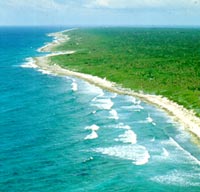 While people living on islands in the Caribbean Sea prepare for Hurricane Ivan, others nearby -- at a conference in Mexico City -- announced new findings about humans who lived in the region over 10,000 years ago.
While people living on islands in the Caribbean Sea prepare for Hurricane Ivan, others nearby -- at a conference in Mexico City -- announced new findings about humans who lived in the region over 10,000 years ago.
At the international "Early Man in America" seminar, which ended Friday, September 10, 2004, anthropologists from Mexico's National Institute of Anthropology and History said they believe they have recovered one of the oldest human skeletons ever found in the Americas.
In 2001 and 2002, divers off the coast of the Yucatan Peninsula recovered three skeletons and a number of artifacts from caves that are now underwater. After carbon-dating the remains and doing some additional analysis, the anthropologists believe that these humans lived here during the last Ice Age, when conditions shrunk the seas and exposed these caves to the air.
It is generally accepted that human origins are rooted in Africa. From there, humans migrated to other parts of the world.
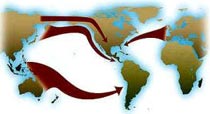 Exactly how and when the first humans arrived in the Americas is still debated. One traditional theory proposes that they walked across a land bridge from Siberia to Alaska about 11,500 years ago, populating the continent from north to south. These people are referred to as the Clovis people.
Exactly how and when the first humans arrived in the Americas is still debated. One traditional theory proposes that they walked across a land bridge from Siberia to Alaska about 11,500 years ago, populating the continent from north to south. These people are referred to as the Clovis people.
A second theory, however -- based on more recent archeological findings, including the remains and artifacts from the underwater caves -- proposes that one or more coastal migrations into South America occurred about 1,000 years earlier than the northern land migration.
Although we can never really know how humans lived and migrated in prehistoric times, archeological findings, along with their scientific analysis and interpretation, shape and support anthropologists' theories.
For this week's lesson, you're going to explore the world of paleoanthropology and how scientists trace the origins, migrations, and lifestyle of prehistoric humans.
Becoming Human
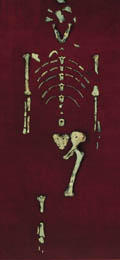 Let's start with as far back as we can go in the human story, and discover what Becoming Human has meant for our species.
Let's start with as far back as we can go in the human story, and discover what Becoming Human has meant for our species.
To explore this site, developed by The Institute for Human Origins, you will need the Flash Player and audio speakers.
In each section, you can Play the Documentary in its entirety and then explore the Related Exhibits, or you can jump to selected exhibits when the viewscreen prompts that you can Learn More at different points in the video. (Note: Some videos do not offer jumps to every Related Exhibit.) When you Close Exhibit, you'll return where you left off. As you move through the content, you can also click underlined words for definitions.
Click on the page where it says to Journey through the story of human evolution, then Begin the Program.
Watch and listen to Paleoanthropologist Don Johanson's introduction, then begin exploring the Evidence section and Play the Documentary.
About how old were the hominid remains found here in Africa? In what ways did Lucy provide new insight which shifted scientific theories about human evolution?
Browse through the Related Exhibits, starting with The Scientific Method.
How exactly does the "Circle of Science" work? What are the three major principles of scientific thinking? In what other science fields have your seen the circle and these principles applied?
Move to the next Related Exhibit, Finding Fossils. How are fossils and dig sites found and catalogued?
Go to the third exhibit in this section, to Explore a Dig. Here, you'll meet several different types of scientists who work together to reconstruct what the site looked like and who and what lived there thousands of years ago. After one scientist explains his or her role, place your cursor over the Venture Forward icon to move through the dig site.
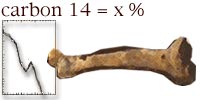 Once human fossils are found, then what? In the next Evidence exhibit, you'll learn about Profiling Fossils. How do scientists determine the species of hominid, the gender, the age upon death, and how healthy he or she was?
Once human fossils are found, then what? In the next Evidence exhibit, you'll learn about Profiling Fossils. How do scientists determine the species of hominid, the gender, the age upon death, and how healthy he or she was?
Next, find out how The Dating Game works, why Context Clues are important, and exactly how scientists go about Interpreting the Evidence.
What are some of the different methods of dating fossils found at a site? Why is recognizing the context of where a fossil was discovered critical to interpreting the evidence, and to the Circle of Science?
Also, learn more about how scientists go about Reconstructing Environments and what role Environmental Impacts have played in shaping hominid lifestyles and movements.
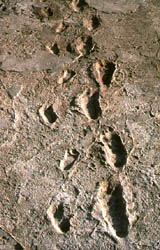 Now begin exploring the site's Anatomy section and Play the Documentary. Explore the various Related Exhibits during the video or afterward.
Now begin exploring the site's Anatomy section and Play the Documentary. Explore the various Related Exhibits during the video or afterward.
How exactly are we related to chimpanzees? Why was the evolution of bidpedalism important to hominid development? What other kinds of physical and mental skills did our early ancestors possess that made it possible for them to migrate and multiply so successfully?
As you'll soon discover in the Lineages section, there is still argument over why the Neanderthals seem to have disappeared. What do you think happened? How would your viewpoint shape the Human Family Tree?
Now check out how human Culture evolved. In what ways did consciousness and creativity influence how they viewed themselves and others in the world? How did fulfilling our basic needs as a social group -- food gathering, defending against predators, etc. -- help humans develop other skills such as language and art?
If you have time, check out the BBC's Cavemen site, and take the Cavemen Challenge. Browse the rest of the site for an extended look at our prehistoric past.
Newspaper Activities
In issues of Targetnewspaper, keep an eye out for any stories about new discoveries of hominid artifacts or remains, new developments in human evolution theories, or about an individual paleoanthropologist. What details are especially notable? How or where does the evidence, theory or individual's work fit into what you've learned about hominid development? Does it or the individual support or undermine generally accepted notions?
© Copyright 2004
Learners
Online,
Inc.
